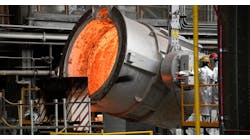If you need to clean up your casting operation and increase your profit margin at the same time, start at the areas that generate the most airborne silica dust. The primary source of dust is the vibrating shakeout and sand carryover, coupled with the amount of sand still attached to the castings after shakeout.
When a green-sand mold is dumped onto a conventional vibrating shakeout, a large amount of fine silica dust is released into the workplace. It is difficult to capture all the steam laden with silica dust due to the amount of open area, so the foundry environment becomes dirty.
The amount that is released is directly related to the sand temperature at shakeout. When the average sand temperature exceeds 100°C, the convection currents carry silica dust into the foundry atmosphere. The higher the sand temperature at shakeout, the greater will be the convection current velocity and amount of steam and dust to be captured.
With a sand-to-metal ratio lower than 6.9:1, the average sand temperature will exceed 100°C. The convection current velocity increases significantly from 100° to 200°C.
The heat-affected zone of the mold is the area where the molten metal comes into direct contact with the sand grains (mold face). As the sand expands in this zone, internal stresses cause weak grains to fracture. Since sand quality varies around the world, the source of supply will directly impact the volume of fines generated from both mechanical and thermal aspects.
Another important calculation tells us that for every kilo of metal poured into the mold, 15% by weight of new sand should be added to replenish the losses and keep the sand system in balance. Since the amount of cores may vary from job to job, using core sand as new sand additions can be a hit-or-miss method unless it is separated from the green sand and then metered back in at a given rate.
Controlling airborn sand
The second source of airborne silica dust is sand still attached to the castings after shakeout (in pockets, cavities, and corners). As heat from the metal drives out the moisture, the loose sand falls off and contaminates downstream operations. Workers in cleaning, finishing, and melting departments are exposed to silica dust.
Dust is also generated when these “sandy” castings are shot-blasted. The sand that goes into the shot-blast system contributes to wear on the equipment, but it also degrades and adds to the waste stream. This translates into increasing sand-disposal costs. The sandy returns that go back to remelt without being shot-blasted, lower the melting efficiency, and increase the volume of slag, the need for slag handling, and slag-disposal costs.
Foundries’ determination to make their operations cleaner, and to lower operating and labor costs, has helped Didion introduce innovations in sand-casting separation and cleaning, leading to hundreds of thousands of dollars in annual savings.
Multi-purpose, single step
Didion’s latest invention is its patented Mark 5 Series Rotary Media Drum that performs shakeout, sand conditioning, double sand screening, casting cleaning, and casting cooling in a single efficient step. Foundries stay much cleaner because airborne silica dust declines, and it offers the lowest operating cost-per-ton of any comparable package available to the global foundry community. Didion projects that combining these processes will cut operating costs $40-80 per ton.
Foundries benefit in a number of ways, including: less capital equipment to purchase; less floor space; much lower energy costs; less maintenance time and cost; lower shot consumption; fewer replacement parts; cleaner working conditions; and cleaner returns to remelt, which reduces slag build-up.
The Mark 5 Series streamlines production with cool and clean castings going directly to the finishing department. Return sand is blended and conditioned, so it is consistent in temperature and moisture content and provides better control at a mixer. Sand stays in the system where it belongs, so the foundry stays cleaner.
Dust collection is highly efficient thanks to the drum’s small, open area. It requires 75% less dust collection than a vibrating shakeout rated at the same capacity. Counterflow air eliminates fugitive dust from escaping, protecting workers from airborne silica dust.
Many foundries shot-blast their castings twice: first to pre-clean the castings and returns; then, after casting grinding, to blend in the grinding marks. Since the new Mark 5 also cleans the castings, the first shot blast step can be eliminated. Gates, runners, and sprue are often removed in the Didion system, so there’s no manual labor involved and the clean returns go directly back to remelt.
Didion says this is the first and only shakeout system that separates core sand from green sand, and discharged independently at separate points. This unique feature is popular among high-volume automotive foundries with heavy cored work that need to meter only 15% core sand back into the green sand system.
These variable-speed machines allow the foundry operators to control the action. The media bed protects nonferrous and fragile castings while cleaning and cooling. Custom lining configurations are available for aluminum, brass, malleable gray, ductile, and steel castings. Installations include green-sand, shell, no-bake, and lost-foam systems.
Recent improvements to the Mark 5 Series include thicker and wider interlock liners that last longer; 50% fewer seams and contoured rifling for delicate castings; self-relieving, tapered separation chambers; split pillow-block end trucks with quick-change bearing inserts; and automatic chain tensioning.
System improvements include water quenching directly following the machine to eliminate long cooling conveyors, further saving equipment costs, energy, time, and space. For foundries using casting baskets and stage cooling, water quenching following the Rotary Media Drum can streamline production flow and eliminate the bottleneck in the cleaning room.








